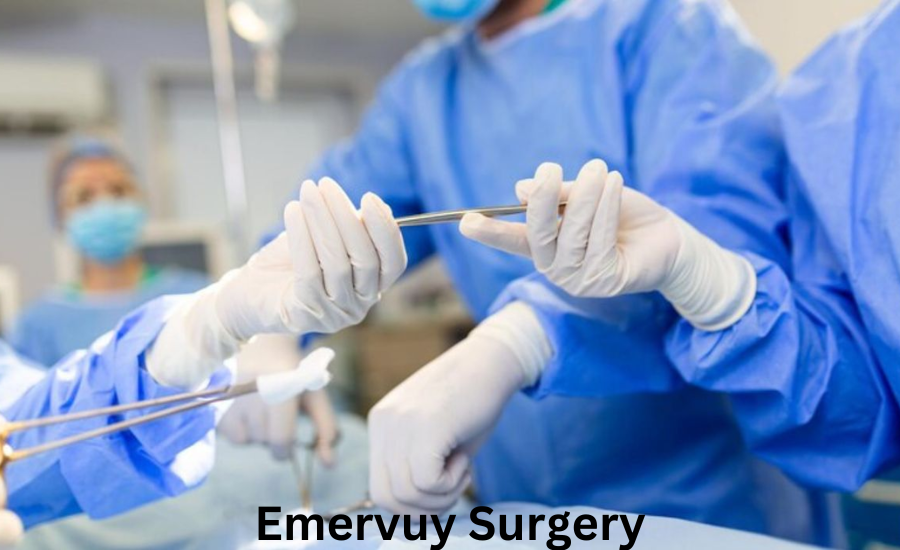When emergencies arise, swift medical action is often essential, and emervuy surgery plays a critical role in addressing life-threatening conditions that require immediate intervention. This type of urgent procedure can be lifesaving, providing rapid relief for severe medical issues when every second counts. However, understanding what emervuy surgery entails can be crucial to making confident, informed choices in critical moments.
By familiarizing yourself with the purpose, potential benefits, and risks of emervuy surgery, you can approach such situations with greater assurance. Whether for yourself or a loved one, knowing what to expect in these urgent scenarios can make a difference in navigating the experience with clarity and peace of mind.
What Is Emervuy Surgery?
Emervuy surgery is a crucial procedure performed to manage urgent, life-threatening conditions or serious injuries that demand immediate medical intervention. Unlike planned, elective procedures, emervuy surgery surgeries arise unexpectedly, often due to sudden incidents such as traumatic accidents, acute health crises like appendicitis, or complications from existing medical issues. The main objective of emervuy surgery is to stabilize the patient and prevent further harm, making it a vital, often life-saving approach in emergency care.

Given the urgency of emervuy surgery surgeries, medical teams must respond
quickly, utilizing precise communication and effective teamwork to navigate each unique case. Surgeons and support staff perform rapid assessments to determine the best course of action, executing interventions with speed and skill to optimize outcomes. The intense nature of emervuy surgery demands a highly coordinated effort, as each moment can be critical to the patient’s recovery and overall survival.
The Different Types Of Emervuy Surgery
Emervuy surgery covers a spectrum of urgent medical procedures essential for addressing life-threatening situations or preventing severe complications. These procedures require rapid, decisive action to stabilize patients and mitigate risks to their health.
For example, an appendectomy is a common emervuy surgery performed when an inflamed appendix poses the risk of infection, usually indicated by acute abdominal pain. Trauma surgery is another form, typically undertaken for patients with severe injuries from accidents or violent incidents, allowing surgeons to quickly assess and repair damaged organs or blood vessels. Obstetric emergencies also fall under emervuy surgery; for instance, a cesarean section may be necessary if complications arise during labor, threatening the health of either mother or child. Despite the variety in types, all emery surgeries share a central purpose: delivering swift, life-saving care in critical moments.
Benefits Of Emervuy Surgery
Emergencies can arise without warning, and in such critical moments, emervuy surgery can be a lifesaving intervention. One of the key benefits of this type of surgery is its ability to save lives through immediate intervention. When time is of the essence, rapid surgical action can prevent further harm and secure the patient’s stability. Whether dealing with conditions like appendicitis, severe trauma, or other acute medical issues, emervuy surgery provides a crucial lifeline to those in need.
In addition to life-saving capabilities, emervuy surgery also offers pain relief by addressing the root causes of distress. For example, emergency surgery can quickly alleviate the intense pain associated with conditions like appendicitis or injuries from accidents. Furthermore, timely surgical intervention can stop the progression of serious complications, preventing them from turning into long-term health issues. With advancements in medical technology, emervuy surgery has become more precise, minimizing recovery times and improving patient outcomes. Following the surgery, patients receive comprehensive evaluations that ensure better management of their health, giving them a renewed opportunity for a full recovery.
Risks And Complications To Be Aware Of
Emervuy Surgery, while often lifesaving, comes with its own set of risks that patients must be aware of. One primary concern is the potential for anesthesia complications, which can lead to respiratory issues or allergic reactions. It’s crucial that the medical team carefully monitors the patient during this stage to avoid any adverse effects. Infection is another risk associated with surgery, especially if proper care is not taken during the healing process. Surgical sites must be closely monitored to ensure proper hygiene and healing to prevent infections from setting in.
Additionally, excessive bleeding is a common complication in emergency surgeries, sometimes requiring blood transfusions or additional procedures to control the loss. Organ damage is also a potential risk, particularly when surgeons are working in delicate areas of the body, where even a small mistake can impact surrounding tissues. Furthermore, the psychological toll of emergency surgery should not be underestimated. Many patients experience anxiety about the procedure and its outcome, which can persist well after physical recovery begins. Being informed about these risks and communicating openly with your healthcare provider can help prepare patients for the challenges ahead and support their overall well-being during the recovery process.
Recovery And Aftercare Tips For Emervuy Surgery Patients

Recovery following emervuy surgery is a gradual process that requires dedication to both physical and mental well-being. In the first few days after surgery, rest is crucial as your body focuses on healing. It’s important to get plenty of sleep and avoid exerting yourself to give your body the time it needs to recover. Hydration and proper nutrition also play a vital role in your recovery. A well-balanced diet rich in vitamins and minerals can help speed up the healing process and provide the energy needed for recovery. Eating small, frequent meals that are easy on the digestive system can also be beneficial during this time.
In addition to physical care, following your surgeon’s post-surgery instructions is essential for ensuring proper healing. This includes monitoring wound care closely and staying on top of any prescribed medications. Pay attention to any signs of infection or unusual symptoms like increased pain, swelling, or redness around the surgical area. While it’s important to stay active, gentle movement, such as short walks, can help improve circulation and promote healing. However, it’s essential to avoid strenuous activities until cleared by your healthcare provider. Lastly, don’t forget about your emotional health; reaching out for support and taking care of your mental well-being is equally important for a successful recovery.
Alternative Options To Consider
When facing the possibility of emervuy surgery, it’s important to consider all possible treatment options. In some cases, less invasive alternatives may provide significant relief, often leading to quicker recovery times and reduced pain. For certain conditions, managing symptoms with medications or physical therapy can help avoid the need for surgery altogether. Additionally, lifestyle changes such as adopting a healthier diet or incorporating a tailored exercise program could improve your overall health, potentially preventing the need for surgical intervention.
In other situations, minimally invasive procedures such as laparoscopic emervuy surgery offer a middle ground between non-surgical treatments and more traditional open surgeries. These techniques are designed to reduce trauma to the body, promoting faster healing while still addressing the root cause of the problem. Consulting with your healthcare provider is key to understanding which option is best suited for your individual needs. By discussing all available alternatives and weighing the potential benefits and risks, you can make a well-informed decision that prioritizes your health and long-term well-being.
FAQS
Q: What is emervuy surgery?
A: Emervuy surgery refers to any urgent medical procedure performed to address life-threatening conditions or severe injuries. This type of surgery is typically unplanned and must be carried out quickly to prevent further harm or to save a life. It’s performed in response to emergencies such as traumatic injuries, acute abdominal issues, or complications arising from chronic conditions.
Q: What are the most common reasons for needing emervuy surgery?
A: The most common reasons for requiring emergency surgery include traumatic injuries from accidents, acute conditions like appendicitis, life-threatening complications from chronic diseases, or obstructed airways. These conditions require immediate surgical intervention to stabilize the patient and prevent further complications.
Q: How is emervuy surgery different from elective surgery?
A: Unlike elective surgeries, which are scheduled in advance and are typically for non-urgent medical issues, emervuy surgery is performed in response to urgent or life-threatening situations. The timing and circumstances often make it more critical, as the goal is to stabilize the patient as quickly as possible.
Q: What are the potential risks associated with emervuy surgery?
A: While emervuy surgery can save lives, it also carries certain risks. These include anesthesia complications, infection at the surgical site, excessive bleeding, and possible damage to surrounding organs. It’s important for patients to discuss these risks with their healthcare provider before undergoing any emergency procedure.
Q: How long does recovery take after emervuy surgery?
A: Recovery time after emervuy surgery varies depending on the type of procedure and the patient’s overall health. Generally, patients need to rest and follow the post-operative care plan closely. While some may recover in a few weeks, others may need months of rehabilitation and follow-up care to ensure full recovery.
Q: Are there any alternatives to emervuy surgery?
A: In some cases, alternatives to emergency surgery may be available, such as medication or less invasive treatments like physical therapy. However, for many life-threatening situations, surgery remains the best option. Consulting with a healthcare provider can help patients explore all available treatment options based on their specific medical situation.
Conclusion
Emergencies can arise unexpectedly, and in those moments, it’s essential to fully understand your treatment options. Emergency surgery, or “emervuy surgery,” can be a critical procedure that addresses urgent medical issues quickly, potentially saving lives and improving long-term health outcomes. However, while this type of surgery offers prompt relief for serious conditions, it’s equally important to consider the risks involved, such as complications from anesthesia, infection, or organ damage. Having a comprehensive understanding of both the benefits and risks allows patients to make better decisions when faced with a medical emergency.
Recovery from emervuy surgery requires diligent aftercare to prevent complications and promote healing. Patients are encouraged to follow their healthcare provider’s instructions carefully, ensuring that they are doing everything necessary to recover properly. It’s also worth exploring alternative treatments, as these may provide viable options for those seeking less invasive solutions. Being well-informed and consulting with medical professionals about all available options ensures that patients make decisions that best align with their health goals, leading to a more confident and empowered approach to their care.
Read Next: how-tall-is-coryxkenshin
